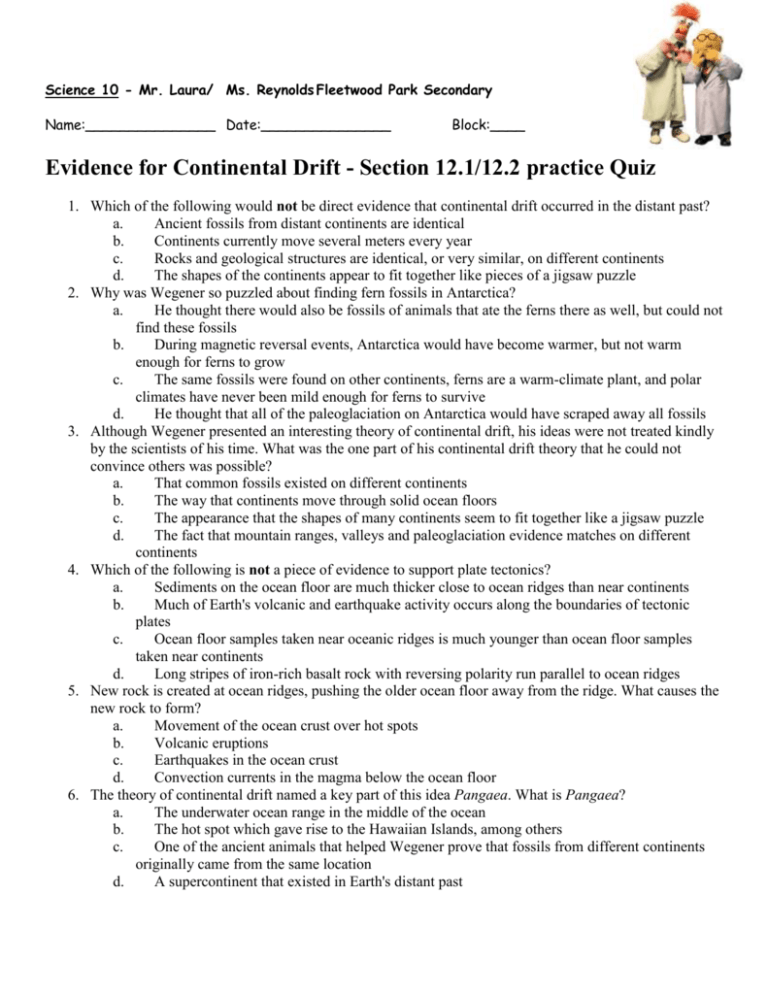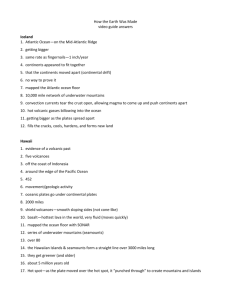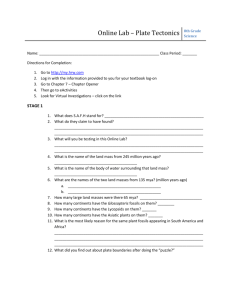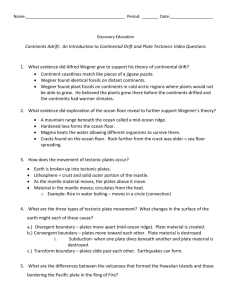Science 10 - Mr. Laura/ Ms. Reynolds Fleetwood Park Secondary
advertisement

Science 10 - Mr. Laura/ Ms. Reynolds Fleetwood Park Secondary Name:_______________ Date:_______________ Block:____ Evidence for Continental Drift - Section 12.1/12.2 practice Quiz 1. Which of the following would not be direct evidence that continental drift occurred in the distant past? a. Ancient fossils from distant continents are identical b. Continents currently move several meters every year c. Rocks and geological structures are identical, or very similar, on different continents d. The shapes of the continents appear to fit together like pieces of a jigsaw puzzle 2. Why was Wegener so puzzled about finding fern fossils in Antarctica? a. He thought there would also be fossils of animals that ate the ferns there as well, but could not find these fossils b. During magnetic reversal events, Antarctica would have become warmer, but not warm enough for ferns to grow c. The same fossils were found on other continents, ferns are a warm-climate plant, and polar climates have never been mild enough for ferns to survive d. He thought that all of the paleoglaciation on Antarctica would have scraped away all fossils 3. Although Wegener presented an interesting theory of continental drift, his ideas were not treated kindly by the scientists of his time. What was the one part of his continental drift theory that he could not convince others was possible? a. That common fossils existed on different continents b. The way that continents move through solid ocean floors c. The appearance that the shapes of many continents seem to fit together like a jigsaw puzzle d. The fact that mountain ranges, valleys and paleoglaciation evidence matches on different continents 4. Which of the following is not a piece of evidence to support plate tectonics? a. Sediments on the ocean floor are much thicker close to ocean ridges than near continents b. Much of Earth's volcanic and earthquake activity occurs along the boundaries of tectonic plates c. Ocean floor samples taken near oceanic ridges is much younger than ocean floor samples taken near continents d. Long stripes of iron-rich basalt rock with reversing polarity run parallel to ocean ridges 5. New rock is created at ocean ridges, pushing the older ocean floor away from the ridge. What causes the new rock to form? a. Movement of the ocean crust over hot spots b. Volcanic eruptions c. Earthquakes in the ocean crust d. Convection currents in the magma below the ocean floor 6. The theory of continental drift named a key part of this idea Pangaea. What is Pangaea? a. The underwater ocean range in the middle of the ocean b. The hot spot which gave rise to the Hawaiian Islands, among others c. One of the ancient animals that helped Wegener prove that fossils from different continents originally came from the same location d. A supercontinent that existed in Earth's distant past 7. Earth's tectonic plates "float" on a layer of molten rock like cookies floating in boiling milk. The continents are embedded in the tectonic plates like chocolate chips in the cookie. What is the name of the process that allows this movement to occur, and where does the process take place? a. Convection currents in the crust, known as the lithosphere b. Convection currents in the lower mantle, known as the lithosphere c. Mantle convection currents in the upper mantle, known as the asthenosphere d. Mantle conduction currents in the upper mantle, known as the asthenosphere 8. The following illustration depicts the movement of tectonic plates. What is the name of the process occurring at C, where one part of a tectonic plate tugs the rest of the plate along as it returns into the lower portions of the mantle? a. Ridge pull b. Slab pull c. Slab push d. Ridge push 9. Subduction zones are sites of convergent plate interactions. Here, a more dense tectonic plate pushes below a less dense tectonic plate, forming a trench. In the illustration, where is the subduction zone, or trench? a. F b. E c. A d. D 10. What is the name of divergent boundary found on land that exhibits the same process that occurs at E? a. Rift valley b. Volcano c. Ocean ridge d. Earthquake 11. The following illustration depicts some of Earth's tectonic plates and their boundaries. In order, what are the plate boundaries located at A, B and C? a. Convergent, Transform and Divergent b. Convergent, Divergent and Transform c. Divergent, Convergent and Transform d. Transform, Convergent and Divergent







